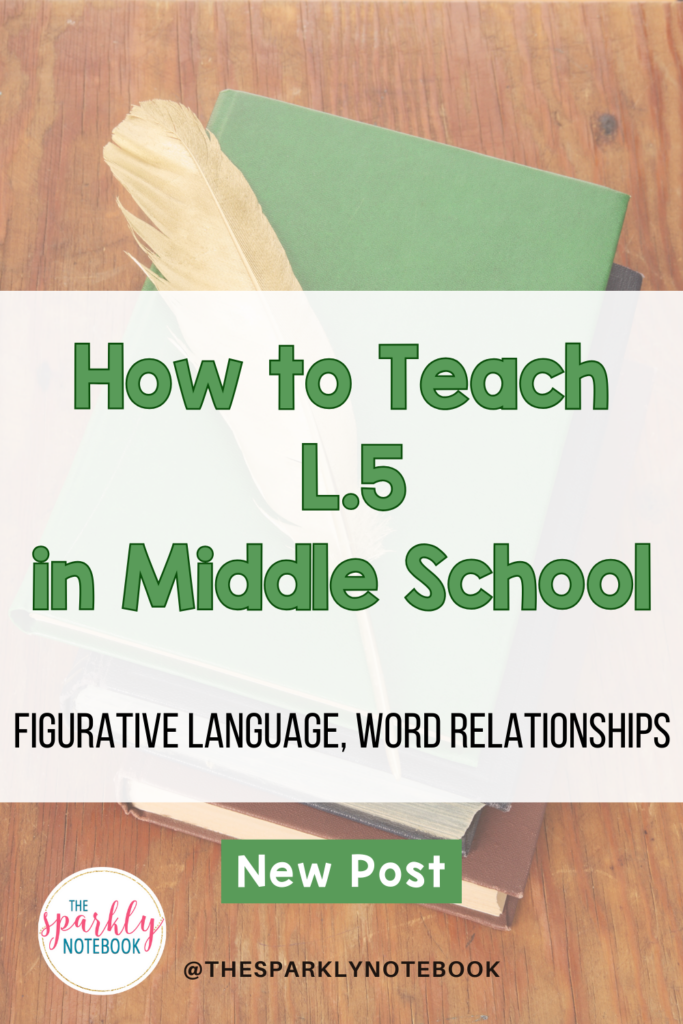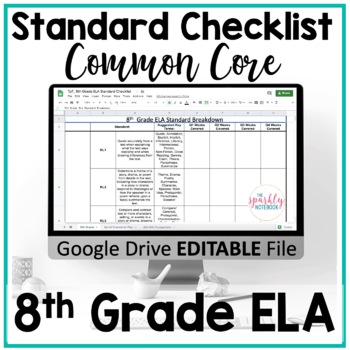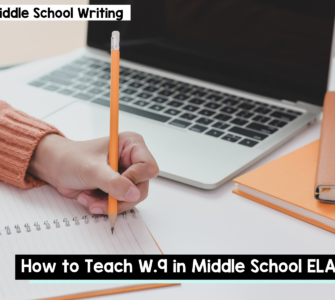A breakdown for teachers who teach L.5 in middle school ELA. In this post, we’ve included learning targets, concept breakdowns, resource suggestions, and activity and assessment ideas!
Not everything is as it seems. That is the main message behind the L.5 standard.
In my mind, as an ELA teacher, I think of the L.5 standard as the “idiom standard.” Often, when we teach students about idioms, we talk about how some of our common sayings would seem really odd to people who aren’t from this country or are not familiar with the way we speak. The meaning we hope to relay by using the idiom may be lost on someone who is not from the same region as we are.
Most figurative language works that way, and as students learn to write and use language, they have to also learn the nuances of language.
Audience also affects the use of language. As most people reading this post are probably ELA teachers, you may be quick to point out or notice any dangling modifiers I have hanging around, or you may notice that I personified dangling modifiers in that previous statement. These same pieces of information may be lost on someone who is not an ELA teacher.
As we explore how to teach L.5 in middle school, keep in mind the nuances of language and remember that connotations with vocabulary are varied and differ greatly by audience.
Don’t believe me? Ask a teenager what a ‘fit’ is.
As we start talking about how to teach L.5 in middle school, let’s start with the learning targets!

Learning Targets
At the beginning of each year, I like to spend some time looking at all the standards I need to teach my students throughout the year. In addition to looking at the standards for just my grade level, I also spend a lot of time looking at the grades both leading up to mine and the grade after. It is the nuances between the grades that I find the most clarity.
In this post, I discuss in depth how I use the checklists below to plan and break down standards into learning targets. You can do the same! Click on the links below to take a closer look at the standard checklist for each grade level.



Now, let’s look at the learning targets specifically for L.5.
Teaching L.7.5 (7th Grade)

7th Grade Standard: Demonstrate understanding of figurative language, word relationships, and nuances in word meanings.
7th Grade Learning Targets
- I can interpret figures of speech in context.
- I can use the relationship between particular words to better understand each word.
- I can distinguish among the connotations (associations) of words with similar denotations.
Teaching L.8.5 (8th Grade)

8th Grade Standard: Demonstrate understanding of figurative language, word relationships, and nuances in word meanings.
8th Grade Learning Targets
- I can interpret figures of speech in context.
- I can use the relationship between particular words to better understand each word.
- I can distinguish among the connotations (associations) of words with similar denotations.
The Power of the RIGHT Words (or Phrases)
The L.5 standard is the one that takes writing to the next level. Rather than students having simple, one-dimensional writing, the L.5 standard puts emphasis on picking words that say even more than they actually say.
Words have different connotations, and those connotations can change even within different contexts.
For example, if someone from the Midwest talks about going out and “working the field,” I immediately think of someone who is out in a tractor or combine getting crops in and out of the ground.
On the other hand, if I was sitting around with a group of guys at a bar and they talked about “working the field,” I would think they were thinking about their dating options.
And what if the same phrase (“working the field”) was used in a football game? We would think about the variety of passes the quarterback had made or attempted.
Words have power and meaning, and when and where they are used can add to that power and meaning.
As you work through the L.5 standard with students and discuss word choice in more depth, make sure to discuss the different connotations a word or phrase may have in various situations.
Resources for teaching L.5
When I begin making a plan for how to teach L.5 in middle school classes, I like to start with a unit that covers most of the basic content so I can build on that throughout the year.
The resources below provide full coverage of the standard with a focus on the learning targets above.
Each resource includes posters and answer keys as needed, as well as handouts and activities for each learning target.
Activities and Projects for Practicing and Assessing L.5 in Middle School
- Learning Common Idioms and Analogies: Consider having an idiom of the week in your classroom. Ongoing introduction to idioms will help students become more familiar with sayings and phrases from your region and others. You may also choose to include analogies as part of this ongoing practice.
- Images and Irony: Present students with pictures and ask them to write a response to the picture to create three types of irony. We have lessons to help you instruct on irony in the 8th grade resource. That lesson includes this activity.
- Analogy Showdown: Individually or in groups, students will write an analogy for each of a group of provided words like friends/friendships, homework, or even ice cream. We include a different Analogy Showdown handout in each of the 7th and 8th grade resources.
- Connotation Brainstorm: Provide students with images (simple clipart style images work best as they have less background). Have students make a list of their feelings and thoughts associated with each image. Then, bring all those together on a large poster and discuss how we might use the word effectively with those connotations in mind.
Ensuring your students understand and master the standards feels like a huge challenge, and we understand that. The Language standards by themselves could be an entire semester-long class, but in middle school ELA, we have to focus on the writing, reading, speaking, and listening as well. That is why we’ve created resources that fulfill the foundational needs of each of these resources. Using our standards-focused units, will help you to know that you are covering every standard at a foundational level. Plus, you’ll have a whole bunch of assessments, activities, posters, and handouts to use throughout the year as you review and master the standard.
You can get the bundles for each grade level by clicking on the links below. These are the best bang for your buck and will give you all the structure you need to set up a plan that will ensure your students are mastering all the standards this year!
7th Grade Bundle
8th Grade Bundle
 Emergency Sub Planning Made Easy for Middle School ELA Teachers
Emergency Sub Planning Made Easy for Middle School ELA Teachers How to Teach W.9 in Middle School ELA
How to Teach W.9 in Middle School ELA How to teach RL.9 in Middle School
How to teach RL.9 in Middle School 